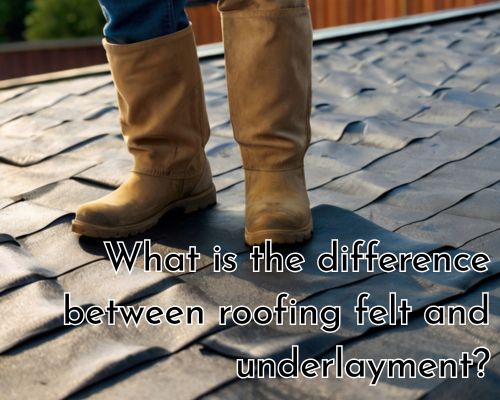What is the Difference Between Roofing Felt and Underlayment? Exploring the Key Differences for Homeowners in West Palm Beach, Florida
When considering a roof replacement or installation, homeowners in West Palm Beach, Florida, are often confronted with terms like roofing felt and underlayment. These two materials are crucial in protecting your home from water damage and ensuring a durable roof. But what exactly is the difference between roofing felt and underlayment, and how do they impact the lifespan of your roof? With Star Roofing, we’ll break down these materials, focusing on their differences, benefits, and relevance to roofing projects in West Palm Beach.

Understanding Roofing Felt
Roofing felt is a material used to provide an extra layer of protection beneath shingles. Traditionally, it is made of either organic felt (which is made from wood fibers) or fiberglass, coated with asphalt to make it water-resistant. The primary function of roofing felt is to act as a secondary barrier against water infiltration, should the shingles fail. It has been a standard component in roofing systems for decades.
Roofing felt is available in different weights, typically measured in pounds per square (a square is 100 square feet). The most common types include:
- 15-pound felt: Lighter and less expensive, but offers less durability and moisture resistance.
- 30-pound felt: Heavier and more durable, offering enhanced protection against water penetration, making it ideal for homes in areas like West Palm Beach, where heavy rain and hurricanes are a concern.
Despite its widespread use, roofing felt has some limitations, especially in modern roofing systems. It tends to tear easily and may not perform as well in extreme weather conditions, which is why many homeowners in Florida are exploring other options like synthetic underlayment.
Exploring Underlayment: The Modern Alternative
Underlayment is a more modern alternative to traditional roofing felt. It serves the same primary function of providing an additional layer of protection beneath roofing shingles, but with significant improvements in durability and performance. Unlike roofing felt, which is primarily asphalt-based, underlayment is usually made from synthetic materials such as polyester, polypropylene, or fiberglass.
The key differences between underlayment and roofing felt are:
- Material Composition: Roofing felt is typically asphalt-based, while underlayment is made from synthetic materials, which are more durable and resistant to water penetration.
- Durability and Flexibility: Underlayment is more flexible and resistant to tearing, making it more suitable for high-wind areas like West Palm Beach, where storms and hurricanes are common.
- Water Resistance: Underlayment, particularly the synthetic types, generally offers superior water resistance compared to roofing felt, which can degrade over time when exposed to moisture.
- Ease of Installation: Synthetic underlayment is typically lighter and easier to handle than roofing felt, making it easier to install, particularly in locations with complex roof structures.
Types of Underlayment for Florida Homes
In Florida, where the climate is characterized by hot, humid summers and frequent storms, choosing the right underlayment is essential for long-lasting protection. There are several types of underlayment that homeowners in West Palm Beach can consider:
- Synthetic Underlayment: This is the most common underlayment used in modern roofs. It’s made of a non-woven material that’s both lightweight and durable. Synthetic underlayment is resistant to tearing and is more water-resistant than roofing felt. It can also handle higher temperatures, making it ideal for Florida’s intense heat.
- Rubberized Asphalt Underlayment: This type is designed to provide excellent waterproofing, especially for areas that are particularly vulnerable to leaks, such as valleys, eaves, and around chimneys. It’s a great option for homes in West Palm Beach that need extra protection against rainstorms and hurricanes.
- Peel-and-Stick Underlayment: Another option popular in Florida is peel-and-stick underlayment. This material has an adhesive backing that sticks directly to the roof deck, creating a watertight seal. It’s especially useful in areas with a high risk of wind damage. Go to a roofing contractor for more.
Why Is Underlayment More Popular than Roofing Felt in West Palm Beach?
Given the tropical climate of West Palm Beach, roofing materials need to withstand extreme weather conditions, including high humidity, heavy rainfall, and strong winds. Underlayment, particularly synthetic and rubberized asphalt varieties, offers superior protection and longer-lasting performance than traditional roofing felt.
Benefits of Synthetic Underlayment in Florida:
- Enhanced Durability: Synthetic underlayment is more durable than roofing felt, particularly under extreme conditions. It won’t break down as quickly when exposed to moisture, making it a better choice for Florida’s wet climate.
- Superior Water Resistance: Unlike roofing felt, synthetic underlayment provides a stronger barrier against water penetration. It can prevent leaks even during heavy storms, which are common in West Palm Beach.
- Wind Resistance: Many types of synthetic underlayment are designed to withstand high winds. This is critical for homeowners in West Palm Beach, where hurricanes and tropical storms are frequent threats.
- Better UV Resistance: Florida’s intense sunlight can degrade traditional roofing felt over time. Synthetic underlayment is more resistant to UV radiation, making it a more reliable choice for long-term roofing solutions in the state.
Which One is Better for Your Home in West Palm Beach?
Choosing between roofing felt and underlayment for your roof installation or replacement depends on several factors, including your budget, the type of roofing materials you’re using, and the level of protection you need.
- Roofing Felt: Roofing felt may still be a viable option for budget-conscious homeowners in West Palm Beach. It’s cheaper than synthetic underlayment and can still provide adequate protection in areas that don’t face constant heavy rainfall or winds. However, for homes in high-risk areas or those undergoing a full roof replacement, felt may not be the best long-term investment.
- Underlayment: Given the weather conditions in West Palm Beach, underlayment, especially synthetic or rubberized asphalt types, is often the better choice. It offers superior durability, water resistance, and wind resistance, all of which are essential for homes in Florida. While it may be more expensive than roofing felt, the extra cost is well worth the enhanced protection.
Conclusion: Making the Right Choice for Your Roof in West Palm Beach
Both roofing felt and underlayment are essential components of a roofing system, but when it comes to durability, water resistance, and protection against Florida’s harsh weather conditions, underlayment takes the lead. Homeowners in West Palm Beach, Florida, should consider investing in high-quality underlayment, especially synthetic or rubberized asphalt options, for the best long-term results.
By understanding the difference between roofing felt and underlayment, you can make an informed decision that will help ensure your home remains protected, even in the face of intense Florida storms. Whether you’re installing a new roof or replacing an old one, always consult with a professional roofer who can guide you toward the best materials for your specific needs and climate.


